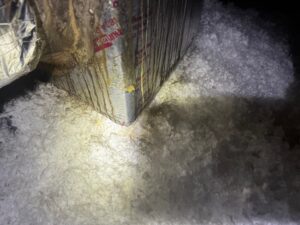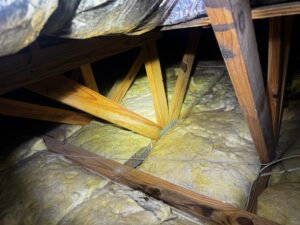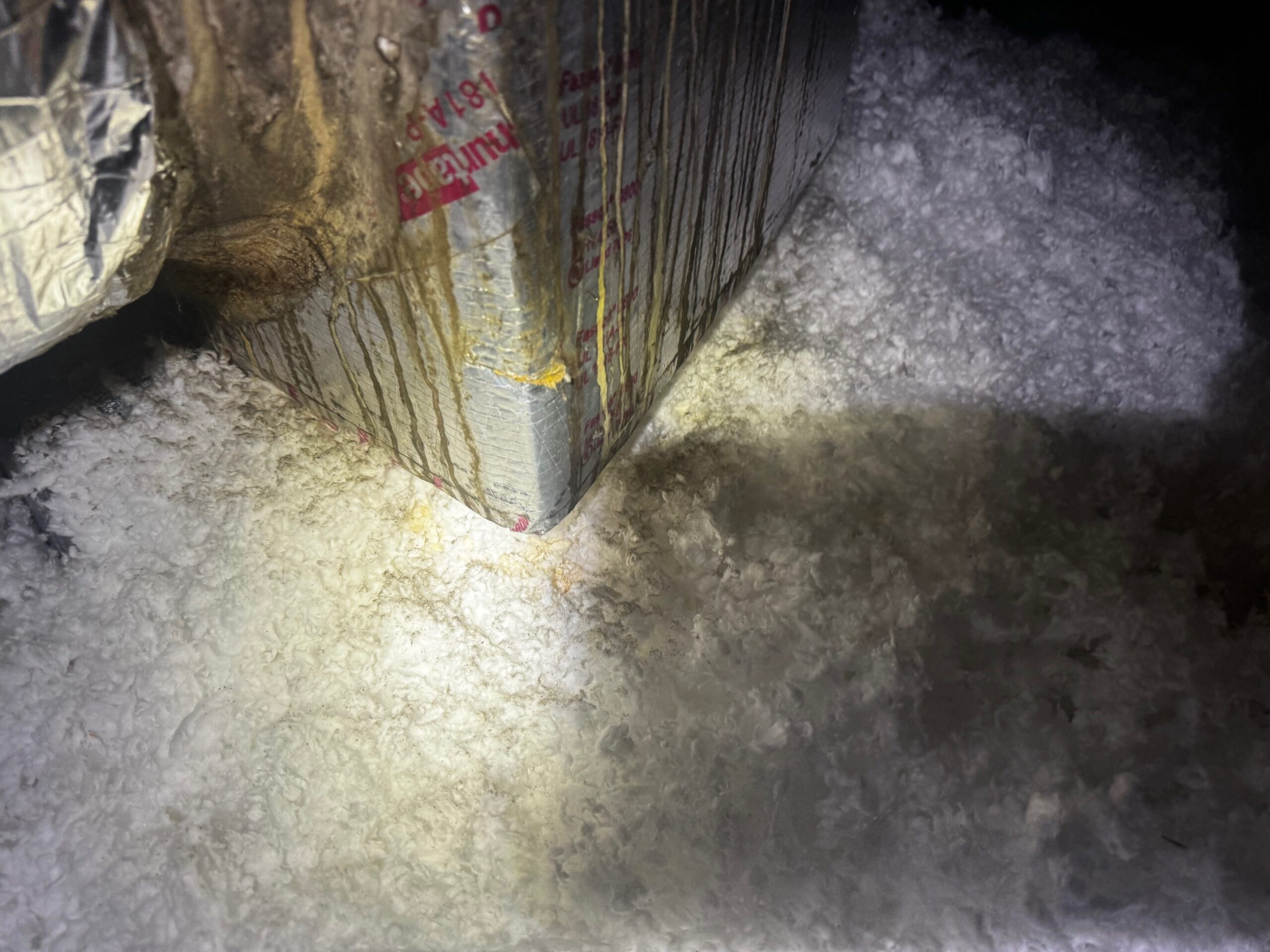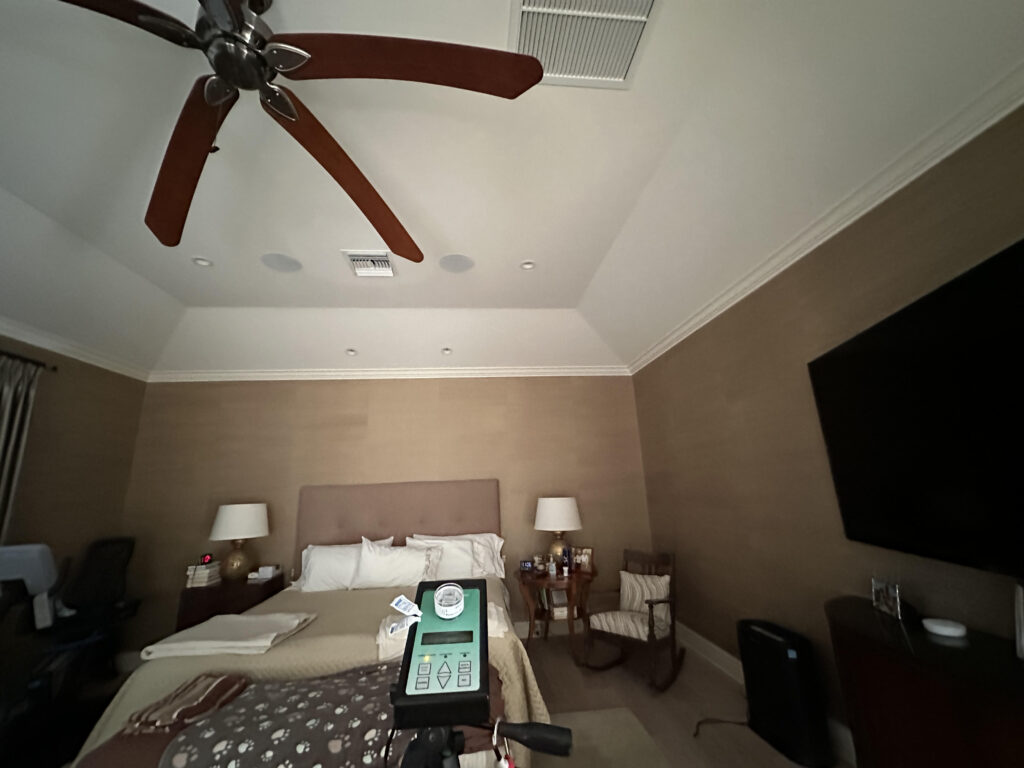During the dog days of summer, one common problem, a major one, that homeowners tend to have it HVAC ducts leaking in the attic. And we are not just talking about air, we are talking also about water. And if it gets excessive, it can lead to not only water damaged insulation but also mold growth. And that is something that NOBODY wants in their attic!

These leaks not only reduce the effectiveness of the HVAC system but also lead to higher energy bills, decreased indoor air quality, and potential damage to the home. Understanding the causes of HVAC air duct leaks is crucial for effective prevention and repair. So let’s look at what the causes are:
1. Poor Installation
One of the primary causes of duct leaks is poor installation. When ductwork is not properly installed, gaps and misalignments can occur, leading to air escaping from the system. Air leakage then leads to condensation. Several issues can arise from improper installation:
- Incorrect Duct Sizing: If the ducts are not sized correctly for the HVAC system, it can result in poor sealing and airflow issues. Ducts that are too large or too small can create spaces where air can leak.
- Improper Sealing: Duct connections and joints need to be sealed correctly to prevent air leaks. If the sealing material, such as duct tape or mastic, is not applied properly, it can deteriorate over time, leading to leaks.
- Inadequate Supports: Ductwork that is not properly supported can sag or shift, causing joints to separate and leading to leaks.
2. Aging Ductwork
As ductwork ages, it becomes more susceptible to leaks due to wear and tear. Several aging-related factors contribute to duct leaks:
- Duct Material Deterioration: Over time, materials like fiberglass or metal can degrade. Fiberglass ducts may develop cracks, while metal ducts can corrode, both of which can lead to leaks. The outside insulation can also start falling apartment from the high humidity in tropical environments.
- Sealant Breakdown: The sealants used to close joints and connections in ductwork can deteriorate over time. When sealants lose their effectiveness, they can cause air to escape from the system.
3. Damage from Pests
Pesky pests such as rodents or insects can cause significant damage to ductwork. They may chew through or create holes in ducts, leading to leaks. The presence of pests not only results in leaks but can also contaminate the air supply with droppings and other debris.
4. Physical Damage
Physical damage to ductwork can occur due to various factors, including:
- Construction Work: Renovation or construction projects can accidentally damage existing ductwork. Tools or heavy equipment may dent, crush, or disconnect ducts, creating leaks.
- Impact Damage: Accidental impacts from moving furniture, heavy objects, or even door slamming can cause ductwork to become misaligned or damaged.
5. Improper Maintenance
Inadequate maintenance can lead to duct leaks. Regular maintenance is essential to keep ductwork in good condition. Neglecting maintenance tasks can result in:
- Accumulation of Debris: Dust and debris can accumulate in ducts and cause clogs or damage. Over time, this can lead to deterioration of the duct material and contribute to leaks.
- Insufficient Insulation: Duct insulation helps maintain the temperature of the air traveling through the ducts. If insulation becomes damaged or is insufficient, it can lead to condensation and subsequent leaks.

6. Poor Duct Design
The design of the ductwork can impact its susceptibility to leaks. Poorly designed duct systems can include:
- Long Duct Runs: Long or convoluted duct runs can increase the risk of leaks at joints and connections. Additionally, long runs may result in higher resistance, causing the system to work harder and exacerbate any leaks.
- Inadequate Returns: Insufficient return air ducts can lead to pressure imbalances within the system, which can cause duct joints to separate or become damaged.
7. Temperature Fluctuations
Temperature fluctuations can affect the integrity of ductwork. Ducts that experience significant changes in temperature can expand and contract, which may lead to:
- Sealant Failure: Frequent temperature changes can cause sealants to become brittle or lose adhesion, resulting in leaks.
- Material Stress: Thermal expansion and contraction can place stress on duct materials, potentially causing cracks or separations.
8. Improper Duct Materials
The choice of duct materials can influence their susceptibility to leaks. Some common issues include:
- Flex Ducts: Flexible ducts, while convenient, are more prone to damage and leaks than rigid metal ducts. They can be easily crushed or torn, leading to leaks.
- Sheet Metal Ducts: Although sheet metal ducts are durable, they can develop leaks if they are not properly sealed or if they corrode over time.
Detecting and Addressing Duct Leaks
Identifying and fixing duct leaks is essential for maintaining HVAC system efficiency and indoor air quality. Here’s how to address the issue:
- Perform a Visual Inspection: Check accessible ductwork for visible signs of damage, such as holes, gaps, or disconnected sections. Pay close attention to joints and connections.
- Conduct a Pressure Test: A professional can perform a pressure test to identify leaks. This involves using specialized equipment to measure air pressure within the ductwork and detect areas of leakage.
- Seal Leaks Properly: Use appropriate sealants, such as mastic or metal tape, to seal any identified leaks. Ensure that the sealing material is compatible with the duct material and can withstand temperature fluctuations.
- Repair or Replace Damaged Ducts: If the ductwork is significantly damaged, it may need to be repaired or replaced. Consult a professional to assess the extent of the damage and determine the best course of action.
- Regular Maintenance: Schedule regular maintenance for your HVAC system to check for and address any potential issues with ductwork. This can help prevent leaks from developing or worsening.
Conclusion
HVAC air duct leaks are a significant issue that can affect system performance, energy efficiency, and cause mold which can lead to indoor air quality issues. Understanding the various causes of duct leaks such as poor installation, aging ductwork, damage from pests, physical impact, and inadequate maintenance can help homeowners and property managers take proactive steps to address and prevent these problems.
By staying vigilant and addressing duct leaks promptly, you can ensure that your HVAC system operates efficiently and that your indoor environment remains comfortable and healthy. Regular inspections and maintenance are key to keeping your ductwork in good condition and avoiding the complications associated with air duct leaks.


